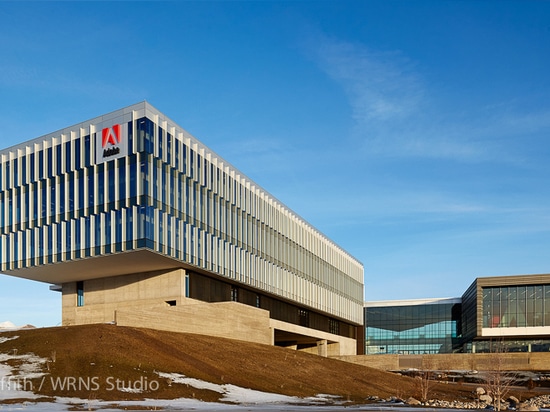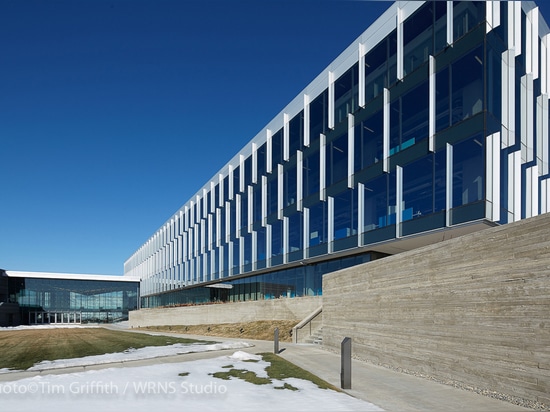
#PUBLIC ARCHITECTURE PROJECTS
Adobe Utah Campus
Utah is easily one of the most beautiful states in America, thanks to its diversity of natural features—from the Bonneville Salt Flats and Great Salt Lake to Canyonlands National Park and Rocky Mountains Basin. The latter provides the gorgeous setting for Adobe's campus in the Utah Valley's Lehi City. The architects answered a few questions about the project
Can you describe your design process for the building?
Adobe chose a 38-acre site in Lehi, which lies between Salt Lake City and Provo. Long and narrow, the site flanks Interstate 15 and is bifurcated by a four-lane public road. It also offers expansive vistas to Utah Valley, the picturesque Lake Utah, and the striking Wasatch and Oquirrh mountain ranges. In the master plan and architecture, we interpreted the Interstate as a natural phenomenon, on the scale of mountains and rivers, to be celebrated for its energy.When we brainstormed ideas with our clients, some of the words they gave us were “innovative,” “athletic,” “eye-catching,” and “bold.” They wanted the building to be a sign to the world that Adobe is about the future. This conversation inspired the cantilevered forms of the buildings, which reach out to the freeway and to the mountains. The cantilevers also allow the buildings to navigate the challenging site, with a 60-foot level change from one end to the other, without the need for extensive grading, which would have added significantly to construction costs. To reinforce Adobe’s commitment to attracting and retaining top talent, we made the campus highly visible to passersby, with extensive glazing to expose the program elements within. We placed the most active areas at the perimeter, so people driving by can see the activity inside—people meeting in conference rooms, crossing the bridge that spans the road, eating in the café, working out in the fitness center, shooting hoops on the basketball court.
To represent Adobe’s creative spirit and reference the Utah Valley’s dramatic topology in our master plan, we configured the campus as flowing lines (three roughly 200,000-square-foot office buildings and an 80,000-square-foot amenities building) and two spaces that are captured by the lines (a grand atrium and a campus green). Just as the sweep of the mountains shapes the inhabited valley, the long sweep of the office floors – scaled to facilitate workplace interaction – defines and embraces the two primary campus spaces. The narrow floor plates provide all employees with access to natural light, expansive views, and a direct connection to the outdoors.
How does the completed building compare to the project as designed? Were there any dramatic changes between the two and/or lessons learned during construction?
Because the team used Revit, our contractor was able to conduct constructability reviews for the project before finishing construction documents, which meant we could identify potential problems and resolve them before construction started. There were no dramatic changes between the building as designed and as constructed, but we did increase our sustainability goal. Originally, we had targeted LEED Silver, but at the end of construction, Adobe decided to aim for LEED Gold. We made numerous small changes to enhance sustainability without increasing the budget.
How does the building compare to other projects in your office, be it the same or other building types?
This was the first major office campus our firm had designed since being founded eight years ago, and the largest project, size wise, we’d done up to that point. It was also one of the first projects for which all the consultants were using Revit, which helped us meet an unusually aggressive schedule with a smaller team than would have otherwise been possible.
How does the building relate to contemporary architectural trends, be it sustainability, technology, etc.?
The complex achieved LEEDv3 Gold certification. Waste heat generated from server rooms warms the atrium. High-performance glass and energy-efficient equipment and fixtures conserve energy, while low-flow plumbing fixtures reduce water consumption. Extensive daylighting lowers the energy demand of artificial lighting. The site is designed to blend with the natural context and handle stormwater in a natural way, with large retention basins that minimize the impact on city infrastructure. Native and drought-tolerant plants lower demand for site water. Large areas of the property are allocated for habitat restoration and will not be used for development in the future.
Use of low-VOC paint, adhesives, carpeting, and composite wood enhances indoor air quality. The project also incorporates recycled content materials and regionally sourced and manufactured materials, as well as wood certified by the Forest Stewardship Council.
Are there any new/upcoming projects in your office that this building’s design and construction has influenced?
We are currently working on several new buildings for Intuit’s campus in Mountain View, CA, that are very similar in size and scope. On Adobe, we learned a lot about how to develop a project that reflected a company’s identity and workplace culture, which has directly impacted our approach to the Intuit project. Adobe also taught us a great deal about the connection of building to the environment spatially, and through its sustainability goals, both of which were stepping stones for Intuit.
How would you describe the architecture of Utah and how does the building relate to it?
Much of the architecture in Utah is often either historicist or simply functional. Located in the Utah Valley, the Adobe campus is surrounded by subdivisions and strip malls. Our clients wanted a big statement that would stand out but also endure. In response, our design took its cues from the landscape—the topology of the valley, which is sandwiched between the Wasatch and Oquirrh mountain ranges. Just as the sweep of the mountains shapes the valley, the sweep of the long office floors define and embrace the two primary campus spaces. The long, narrow shape of the four-story office buildings provides all employees with access to natural light, spectacular views of the mountains, and a direct connection to the outdoors. Essentially, the architecture acts as a frame for nature.





